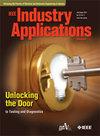Forecasting Flexible Regulation Capabilities of Electric Vehicles: A Probabilistic Approach With Bayesian Neural Networks and Transformer
IF 4.2
2区 工程技术
Q2 ENGINEERING, ELECTRICAL & ELECTRONIC
引用次数: 0
Abstract
Inrecent years, the rapid increase of electric vehicles (EVs) has significantly enhanced the potential for flexible regulation capabilities (FRC) within the power grid. However, the stochastic nature of EV charging behavior poses significant challenges to the accurate evaluation and prediction of FRC. This study introduces a probabilistic prediction method that employs Bayesian Neural Networks combined with Transformer models to achieve FRC prediction under uncertainty. Initially, battery capacity and energy demand for EVs are considered to quantify the FRC of an individual EV, with the aggregated regulation capability obtained using the Minkowski sum method. Subsequently, feature engineering techniques are applied to identify features associated with the flexibility of EVs. Finally, a prediction model is constructed based on the Transformer architecture to forecast FRC of EVs. This model incorporates the ideas of Bayesian Neural Networks by defining the weights and bias parameters in the neural network as probability distributions, thus achieving probabilistic prediction. This study conducts experimental validation using real-world data, and the results demonstrate that the proposed method outperforms other algorithms in terms of prediction accuracy while effectively capturing uncertainty.基于贝叶斯神经网络和变压器的电动汽车柔性调节能力概率预测方法
近年来,电动汽车的快速增长显著增强了电网灵活调节能力的潜力。然而,电动汽车充电行为的随机性给FRC的准确评估和预测带来了很大的挑战。本文介绍了一种利用贝叶斯神经网络结合Transformer模型实现不确定条件下FRC预测的概率预测方法。首先,考虑电动汽车的电池容量和能量需求来量化单个电动汽车的FRC,并使用闵可夫斯基求和法获得总调节能力。随后,应用特征工程技术识别与电动汽车灵活性相关的特征。最后,基于Transformer架构构建了电动汽车FRC预测模型。该模型结合了贝叶斯神经网络的思想,将神经网络中的权重和偏置参数定义为概率分布,从而实现概率预测。本研究使用实际数据进行了实验验证,结果表明,该方法在有效捕获不确定性的同时,在预测精度方面优于其他算法。
本文章由计算机程序翻译,如有差异,请以英文原文为准。
求助全文
约1分钟内获得全文
求助全文
来源期刊

IEEE Transactions on Industry Applications
工程技术-工程:电子与电气
CiteScore
9.90
自引率
9.10%
发文量
747
审稿时长
3.3 months
期刊介绍:
The scope of the IEEE Transactions on Industry Applications includes all scope items of the IEEE Industry Applications Society, that is, the advancement of the theory and practice of electrical and electronic engineering in the development, design, manufacture, and application of electrical systems, apparatus, devices, and controls to the processes and equipment of industry and commerce; the promotion of safe, reliable, and economic installations; industry leadership in energy conservation and environmental, health, and safety issues; the creation of voluntary engineering standards and recommended practices; and the professional development of its membership.
 求助内容:
求助内容: 应助结果提醒方式:
应助结果提醒方式:


